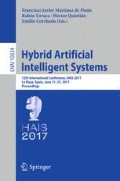Abstract
This preliminary study presents a hybridization of two research fields – evolutionary algorithms and complex networks. A network is created by the dynamic of an evolutionary algorithm, namely Success-History based Adaptive Differential Evolution (SHADE). Network feature, node degree centrality, is used afterward to detect potential design weaknesses of SHADE algorithm. This approach is experimentally tested on the CEC2015 benchmark set of test functions and future directions in the research are proposed.
Access this chapter
Tax calculation will be finalised at checkout
Purchases are for personal use only
References
Storn, R., Price, K.: Differential Evolution-A Simple and Efficient Adaptive Scheme for Global Optimization Over Continuous Spaces, vol. 3. ICSI, Berkeley (1995)
Neri, F., Tirronen, V.: Recent advances in differential evolution: a survey and experimental analysis. Artif. Intell. Rev. 33(1–2), 61–106 (2010)
Das, S., Suganthan, P.N.: Differential evolution: a survey of the state-of-the-art. IEEE Trans. Evol. Comput. 15(1), 4–31 (2011)
Das, S., Mullick, S.S., Suganthan, P.N.: Recent advances in differential evolution–an updated survey. Swarm Evol. Comput. 27, 1–30 (2016)
Wolpert, D.H., Macready, W.G.: No free lunch theorems for optimization. IEEE Trans. Evol. Comput. 1(1), 67–82 (1997)
Omran, M.G.H., Salman, A., Engelbrecht, Andries P.: Self-adaptive differential evolution. In: Hao, Y., et al. (eds.) CIS 2005. LNCS, vol. 3801, pp. 192–199. Springer, Heidelberg (2005). doi:10.1007/11596448_28
Brest, J., Greiner, S., Bošković, B., Mernik, M., Zumer, V.: Self-adapting control parameters in differential evolution: a comparative study on numerical benchmark problems. IEEE Trans. Evol. Comput. 10(6), 646–657 (2006)
Islam, S.M., Das, S., Ghosh, S., Roy, S., Suganthan, P.N.: An adaptive differential evolution algorithm with novel mutation and crossover strategies for global numerical optimization. IEEE Trans. Systems Man Cybern. Part B (Cybern.) 42(2), 482–500 (2012)
Qin, A.K., Huang, V.L., Suganthan, P.N.: Differential evolution algorithm with strategy adaptation for global numerical optimization. IEEE Trans. Evol. Comput. 13(2), 398–417 (2009)
Zhang, J., Sanderson, A.C.: JADE: adaptive differential evolution with optional external archive. IEEE Trans. Evol. Comput. 13(5), 945–958 (2009)
Tanabe, R., Fukunaga, A.: Success-history based parameter adaptation for differential evolution. In: 2013 IEEE Congress on Evolutionary Computation (CEC), pp. 71–78, IEEE, June 2013
Tanabe, R., Fukunaga, A.S.: Improving the search performance of SHADE using linear population size reduction. In: 2014 IEEE Congress on Evolutionary Computation (CEC), pp. 1658–1665, IEEE, July 2014
Das, S., Abraham, A., Chakraborty, U.K., Konar, A.: Differential evolution using a neighborhood-based mutation operator. IEEE Trans. Evol. Comput. 13(3), 526–553 (2009)
Mininno, E., Neri, F., Cupertino, F., Naso, D.: Compact differential evolution. IEEE Trans. Evol. Comput. 15(1), 32–54 (2011)
Mallipeddi, R., Suganthan, P.N., Pan, Q.K., Tasgetiren, M.F.: Differential evolution algorithm with ensemble of parameters and mutation strategies. Appl. Soft Comput. 11(2), 1679–1696 (2011)
Brest, J., Korošec, P., Šilc, J., Zamuda, A., Bošković, B., Maučec, M.S.: Differential evolution and differential ant-stigmergy on dynamic optimisation problems. Int. J. Syst. Sci. 44(4), 663–679 (2013)
Brest, J., Maučec, M.S., Bošković, B.: iL-SHADE: improved L-SHADE algorithm for single objective real-parameter optimization. In: 2016 IEEE Congress on Evolutionary Computation (CEC), pp. 1188–1195, IEEE, July 2016
Viktorin, A., Pluhacek, M., Senkerik, R.: Success-history based adaptive differential evolution algorithm with multi-chaotic framework for parent selection performance on CEC2014 benchmark set. In: 2016 IEEE Congress on Evolutionary Computation (CEC), pp. 4797–4803, IEEE, July, 2016
Poláková, R., Tvrdík, J., Bujok, P.: L-SHADE with competing strategies applied to CEC2015 learning-based test suite. In: 2016 IEEE Congress on Evolutionary Computation (CEC), pp. 4790–4796, IEEE, July 2016
Awad, N.H., Ali, M.Z., Suganthan, P.N., Reynolds, R.G.: An ensemble sinusoidal parameter adaptation incorporated with L-SHADE for solving CEC2014 benchmark problems. In: 2016 IEEE Congress on Evolutionary Computation (CEC), pp. 2958–2965, IEEE, July 2016
Viktorin, A., Hrabec, D., Pluhacek, M.: Multi-chaotic differential evolution for vehicle routing problem with profits. In: Proceedings-30th European Conference on Modelling and Simulation, ECMS 2016. European Council for Modelling and Simulation (ECMS) (2016)
Szenkovits, A., Gaskó, N., Jakab, H.: Optimizing test input generation for reactive systems with an adaptive differential evolution. In: 2016 18th International Symposium on Symbolic and Numeric Algorithms for Scientific Computing (SYNASC), pp. 214–218, IEEE, September 2016
Zamuda, A., Sosa, J.D.H., Adler, L.: Constrained differential evolution optimization for underwater glider path planning in sub-mesoscale eddy sampling. Appl. Soft Comput. 42, 93–118 (2016)
Ekici, B., Chatzikonstantinou, I., Sariyildiz, S., Tasgetiren, M.F., Pan, Q.K.: A multi-objective self-adaptive differential evolution algorithm for conceptual high-rise building design. In: 2016 IEEE Congress on Evolutionary Computation (CEC), pp. 2272–2279, IEEE, July 2016
Karafotias, G., Hoogendoorn, M., Eiben, Á.E.: Parameter control in evolutionary algorithms: trends and challenges. IEEE Trans. Evol. Comput. 19(2), 167–187 (2015)
Zamuda, A., Brest, J.: Self-adaptive control parameters’ randomization frequency and propagations in differential evolution. Swarm Evol. Comput. 25, 72–99 (2015)
Tanabe, R., Fukunaga, A.: How far are we from an optimal, adaptive DE? In: Handl, J., Hart, E., Lewis, Peter R., López-Ibáñez, M., Ochoa, G., Paechter, B. (eds.) PPSN 2016. LNCS, vol. 9921, pp. 145–155. Springer, Cham (2016). doi:10.1007/978-3-319-45823-6_14
Viktorin, A., Pluhacek, M., Senkerik, R.: Network based linear population size reduction in SHADE. In: 2016 International Conference on Intelligent Networking and Collaborative Systems (INCoS), pp. 86–93, IEEE, September 2016
Acknowledgements
This work was supported by Grant Agency of the Czech Republic – GACR P103/15/06700S, further by the Ministry of Education, Youth and Sports of the Czech Republic within the National Sustainability Programme Project no. LO1303 (MSMT-7778/2014). Also by the European Regional Development Fund under the Project CEBIA-Tech no. CZ.1.05/2.1.00/03.0089 and by Internal Grant Agency of Tomas Bata University under the Projects no. IGA/CebiaTech/2017/004.
Author information
Authors and Affiliations
Corresponding author
Editor information
Editors and Affiliations
Rights and permissions
Copyright information
© 2017 Springer International Publishing AG
About this paper
Cite this paper
Viktorin, A., Pluhacek, M., Senkerik, R., Kadavy, T. (2017). Detecting Potential Design Weaknesses in SHADE Through Network Feature Analysis. In: Martínez de Pisón, F., Urraca, R., Quintián, H., Corchado, E. (eds) Hybrid Artificial Intelligent Systems. HAIS 2017. Lecture Notes in Computer Science(), vol 10334. Springer, Cham. https://doi.org/10.1007/978-3-319-59650-1_56
Download citation
DOI: https://doi.org/10.1007/978-3-319-59650-1_56
Published:
Publisher Name: Springer, Cham
Print ISBN: 978-3-319-59649-5
Online ISBN: 978-3-319-59650-1
eBook Packages: Computer ScienceComputer Science (R0)

